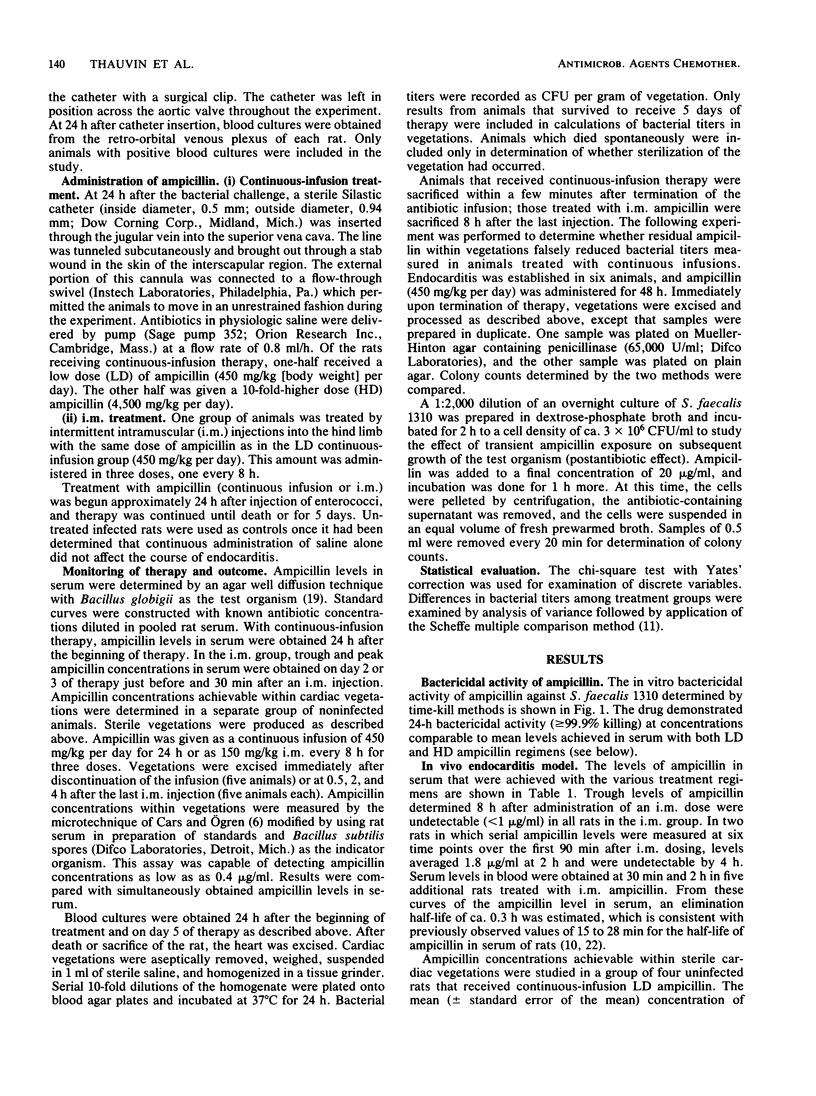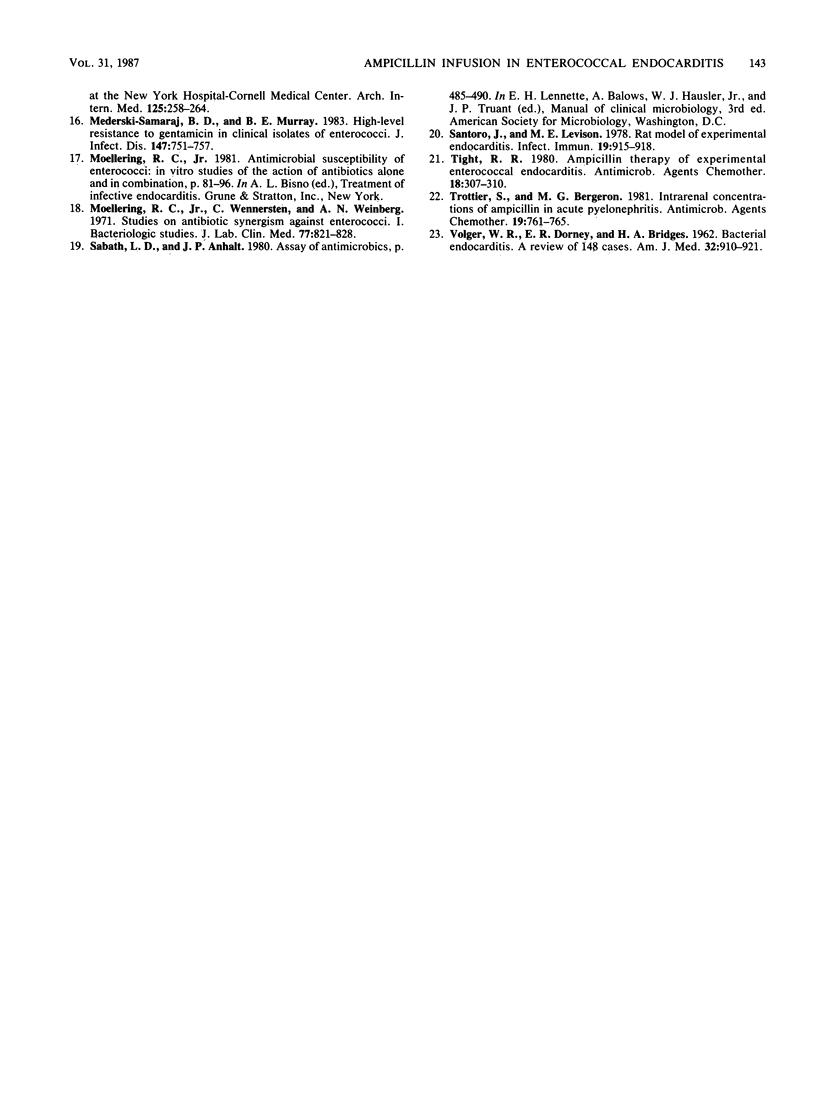Abstract
Intermittent administration of ampicillin alone has resulted in high failure rates in previously described animal models of enterococcal endocarditis. We developed a rat model of enterococcal endocarditis which permits comparison of continuous intravenous infusion of ampicillin with intramuscular therapy. Continuous low-dose ampicillin infusion (450 mg/kg [body weight] per day) was compared with the same dose given intramuscularly in three divided doses and with high-dose infusion (4.5 g/kg per day) of the drug. For the infecting strain of Streptococcus faecalis, the MIC and MBC were 1 microgram/ml. Mean ampicillin levels in serum were 53.9 +/- 4.8 (peak) and less than 1 (trough), 8.7 +/- 1.4, and 244 +/- 29 micrograms/ml for intramuscular, low-dose, and high-dose regimens, respectively. Ampicillin infusion therapy significantly increased the survival rate and sterilization of blood cultures. Continuous infusions were superior to intermittent therapy in eradicating bacteremia. After 5 days of treatment, low-dose ampicillin infusion was more effective than intermittent therapy in sterilizing cardiac vegetations (P less than 0.01). Continuous-infusion therapy at either dose was significantly more effective than intramuscular injection in reducing bacterial titers in cardiac vegetations (5.4 +/- 1.0 log10 CFU/g [low dose], 4.8 +/- 0.3 log10 CFU/g [high dose], and 7.7 +/- 0.3 log10 CFU/g [intramuscular]). However, no statistically significant advantage was found for high-dose compared with low-dose ampicillin infusion in lowering bacterial titers in vegetations (P greater than 0.3).
Full text
PDF




Selected References
These references are in PubMed. This may not be the complete list of references from this article.
- Bakker-Woudenberg I. A., van den Berg J. C., Fontijne P., Michel M. F. Efficacy of continuous versus intermittent administration of penicillin G in Streptococcus pneumoniae pneumonia in normal and immunodeficient rats. Eur J Clin Microbiol. 1984 Apr;3(2):131–135. doi: 10.1007/BF02014330. [DOI] [PubMed] [Google Scholar]
- Barza M., Brusch J., Bergeron M. G., Weinstein L. Penetration of antibiotics into fibrin loci in vivo. 3. Intermittent vs. continuous infusion and the effect of probenecid. J Infect Dis. 1974 Jan;129(1):73–78. doi: 10.1093/infdis/129.1.73. [DOI] [PubMed] [Google Scholar]
- Beaty H. N., Turck M., Petersdorf R. G. Ampicillin in the treatment of enterococcal endocarditis. Ann Intern Med. 1966 Oct;65(4):701–707. doi: 10.7326/0003-4819-65-4-701. [DOI] [PubMed] [Google Scholar]
- Bergeron M. G., Beauchamp D., Poirier A., Bastille A. Continuous vs. intermittent administration of antimicrobial agents: tissue penetration and efficacy in vivo. Rev Infect Dis. 1981 Jan-Feb;3(1):84–97. doi: 10.1093/clinids/3.1.84. [DOI] [PubMed] [Google Scholar]
- Bundtzen R. W., Gerber A. U., Cohn D. L., Craig W. A. Postantibiotic suppression of bacterial growth. Rev Infect Dis. 1981 Jan-Feb;3(1):28–37. doi: 10.1093/clinids/3.1.28. [DOI] [PubMed] [Google Scholar]
- Cars O., Ogren S. A microtechnique for the determination of antibiotics in muscle. J Antimicrob Chemother. 1981 Jul;8(1):39–48. doi: 10.1093/jac/8.1.39. [DOI] [PubMed] [Google Scholar]
- FINLAND M. Treatment of bacterial endocarditis. N Engl J Med. 1954 Mar 4;250(9):372–contd. doi: 10.1056/NEJM195403042500906. [DOI] [PubMed] [Google Scholar]
- GERACI J. E., MARTIN W. J. Antibiotic therapy of bacterial endocarditis. VI. Subacute enterococcal endocarditis; clinical, pathologic and therapeutic consideration of 33 cases. Circulation. 1954 Aug;10(2):173–194. doi: 10.1161/01.cir.10.2.173. [DOI] [PubMed] [Google Scholar]
- Glauser M. P., Lyons J. M., Braude A. I. Synergism of ampicillin and gentamicin against obstructive pyelonephritis due to Escherichia coli in rats. J Infect Dis. 1979 Feb;139(2):133–140. doi: 10.1093/infdis/139.2.133. [DOI] [PubMed] [Google Scholar]
- Godfrey K. Statistics in practice. Comparing the means of several groups. N Engl J Med. 1985 Dec 5;313(23):1450–1456. doi: 10.1056/NEJM198512053132305. [DOI] [PubMed] [Google Scholar]
- Lavoie G. Y., Bergeron M. G. Influence of four modes of administration on penetration of aztreonam, cefuroxime, and ampicillin into interstitial fluid and fibrin clots and on in vivo efficacy against Haemophilus influenzae. Antimicrob Agents Chemother. 1985 Sep;28(3):404–412. doi: 10.1128/aac.28.3.404. [DOI] [PMC free article] [PubMed] [Google Scholar]
- Mandell G. L., Kaye D., Levison M. E., Hook E. W. Enterococcal endocarditis. An analysis of 38 patients observed at the New York Hospital-Cornell Medical Center. Arch Intern Med. 1970 Feb;125(2):258–264. doi: 10.1001/archinte.125.2.258. [DOI] [PubMed] [Google Scholar]
- Mederski-Samoraj B. D., Murray B. E. High-level resistance to gentamicin in clinical isolates of enterococci. J Infect Dis. 1983 Apr;147(4):751–757. doi: 10.1093/infdis/147.4.751. [DOI] [PubMed] [Google Scholar]
- Moellering R. C., Jr, Wennersten C., Weinberg A. N. Studies on antibiotic synergism against enterococci. I. Bacteriologic studies. J Lab Clin Med. 1971 May;77(5):821–828. [PubMed] [Google Scholar]
- Santoro J., Levison M. E. Rat model of experimental endocarditis. Infect Immun. 1978 Mar;19(3):915–918. doi: 10.1128/iai.19.3.915-918.1978. [DOI] [PMC free article] [PubMed] [Google Scholar]
- Scheld W. M., Mandell G. L. Enigmatic enterococcal endocarditis. Ann Intern Med. 1984 Jun;100(6):904–905. doi: 10.7326/0003-4819-100-6-904. [DOI] [PubMed] [Google Scholar]
- Tight R. R. Ampicillin therapy of experimental enterococcal endocarditis. Antimicrob Agents Chemother. 1980 Aug;18(2):307–310. doi: 10.1128/aac.18.2.307. [DOI] [PMC free article] [PubMed] [Google Scholar]
- Trottier S., Bergeron M. G. Intrarenal concentrations of ampicillin in acute pyelonephritis. Antimicrob Agents Chemother. 1981 May;19(5):761–765. doi: 10.1128/aac.19.5.761. [DOI] [PMC free article] [PubMed] [Google Scholar]
- VOGLER W. R., DORNEY E. R., BRIDGES H. A. Bacterial endocarditis. A review of 148 cases. Am J Med. 1962 Jun;32:910–921. doi: 10.1016/0002-9343(62)90037-2. [DOI] [PubMed] [Google Scholar]


